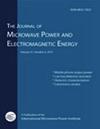编者按:用微波炉做实验
IF 0.9
4区 工程技术
Q4 ENGINEERING, CHEMICAL
Journal of Microwave Power and Electromagnetic Energy
Pub Date : 2020-01-02
DOI:10.1080/08327823.2020.1715584
引用次数: 3
摘要
相当数量的手稿介绍了在不同用途的微波厨房烤箱上进行的实验结果。由于其可及性和低成本,这种烤箱的使用很有吸引力,并且研究人员进行了一些修改,例如改变腔体或仪器,毫无疑问,它们在许多情况下都是有用的。虽然它们的操作很简单,但有一个问题是它们的标称功率并不总是准确的,这在普通家庭应用中不是问题。尽管如此,仍有报道称,即使按照包装上的说明,饭菜也没有达到确保杀死细菌所需的温度,因为饭菜的量和处理时间的相应功率值可能低于预期。其他可微波加热的物品,如加热垫、婴儿配方奶粉和脱毛蜡,都是在这些烤箱里加热的,如果相反的情况发生,那么也有可能过热。当这些烤箱在实验室实验安排中,有必要考虑到微波功率即使在使用中也会变化,因此有时只需要在它们之间进行长时间冷却的短测试,以便重现给定的功率条件。即便如此,实际的磁控管功率是未知的,而通常标称值被报道为应用功率,而不考虑损耗或腔的几何形状。进行这种简单的测试以进行比较或确认材料是否可以用微波加热是完全可以接受的。然而,通常情况下,关于功率稳定性、可靠性和在烤箱中进行的变化的性质的细节没有在手稿中报告,因此,从这些实验中得出结论或验证与功率有关的参数是有问题的。本杂志的目标是微波和射频的非通信应用,这意味着它们被用于干燥、提取和烹饪等目的,旨在实现工业规模或大规模生产。事实上,厨房烤箱是对快餐需求的回应,它是微波最具代表性的非通信应用之一。微波工程的基础设计系统和设备处理材料和物质是由多学科的科学和艺术,包括相互作用的研究物质波,输运现象,材料科学,以及知识的物理,化学和生物性质,如果适用,物质。应用的发展总是需要实验的,而微波炉是很容易获得的,因此有很好的应用研究的例子。然后,提到它的局限性并不反对这种使用,但是在没有讨论修改、限制和对加工条件的真实了解的情况下,否决它们并制定关于动力学和效率问题的结论是不可接受的。最好的期刊论文不一定是基于使用最复杂或最昂贵的设备。研究的目的告诉设备的种类和本文章由计算机程序翻译,如有差异,请以英文原文为准。
Editor’s message: experiments with microwave kitchen ovens
A noticeable number of manuscripts present results of experiments conducted with arrangements based on microwave kitchen ovens for different applications. The use of this kind of ovens is attractive due to its accessibility and low cost, and with several modifications performed by the researchers, such as altering the cavity or instrumentation, there is no doubt about their usefulness in many cases. Although their operation is simple, one problem is that their nominal power is not always accurate, which in regular household applications is not an issue. Still, there are reports of meals that do not reach the necessary temperature to ensure killing bacteria, even following directions on the packets, because the meal amount and processing time are set accordingly to a power value that could be lower than expected. Other microwavable items, such as heat pads, infant formulas, and depilatory wax, are heated in these ovens, and if the opposite occurs, then overheating is also possible. When these ovens are in laboratory experimental arrangements, it is necessary to consider that microwave power varies even under service, so that sometimes only short tests with long cooling times between them are appropriated so that a given power condition is reproducible. Even so, real magnetron power is unknown while often the nominal value is reported as the applied power, without considering losses or cavity geometry. It is quite acceptable to conduct this kind of simple test for comparison purposes or confirming if a material can be heated or not with microwaves. However, often that it should, details regarding power stability, reliability and the nature of the performed changes in the ovens are not reported in the manuscripts, therefore, drawing conclusions or validating parameters related to power from these experiments is questionable. This journal is aimed at non-communication applications of microwaves and RF, meaning that they are employed for purposes such as drying, extracting, and cooking, among others, intended towards industrial-scale or mass production. Indeed, the kitchen oven is a response to the demand for fast food and it is one of the most representative non-communication applications of microwaves. Foundations of microwave engineering for design of systems and devices for processing materials and substances are given by multidisciplinary sciences and arts, that include studies on interaction matter-wave, transport phenomena, materials science, as well as knowledge about the physical, chemical, and biological nature, if applies, of the substances. The development of applications always requires experimentation, and the microwave kitchen oven is quite available, hence there are excellent examples of its application for researching. Then, mention of its limitations is not against this use, yet it is not acceptable to overrule them and formulate conclusions about kinetics and efficiency issues without discussing the modifications, limitations, and true knowledge of the processing conditions. The best journal papers are not necessarily based on the use of the most sophisticated or expensive equipment. The purpose of the research tells the kind of equipment and
求助全文
通过发布文献求助,成功后即可免费获取论文全文。
去求助
来源期刊

Journal of Microwave Power and Electromagnetic Energy
ENGINEERING, CHEMICAL-ENGINEERING, ELECTRICAL & ELECTRONIC
CiteScore
2.50
自引率
6.70%
发文量
21
期刊介绍:
The Journal of the Microwave Power Energy (JMPEE) is a quarterly publication of the International Microwave Power Institute (IMPI), aimed to be one of the primary sources of the most reliable information in the arts and sciences of microwave and RF technology. JMPEE provides space to engineers and researchers for presenting papers about non-communication applications of microwave and RF, mostly industrial, scientific, medical and instrumentation. Topics include, but are not limited to: applications in materials science and nanotechnology, characterization of biological tissues, food industry applications, green chemistry, health and therapeutic applications, microwave chemistry, microwave processing of materials, soil remediation, and waste processing.
 求助内容:
求助内容: 应助结果提醒方式:
应助结果提醒方式:


